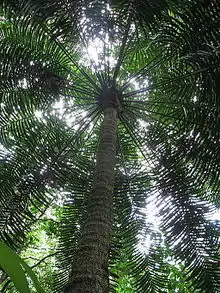Lepidozamia
Lepidozamia is a genus of two species of cycad, both endemic to Australia.[1] They are native to rainforest climates in eastern Queensland and eastern New South Wales. They have a chromosome number of 2n = 18.
| Lepidozamia | |
|---|---|
 | |
| Lepidozamia peroffskyana | |
| Scientific classification | |
| Kingdom: | Plantae |
| Clade: | Tracheophytes |
| Division: | Cycadophyta |
| Class: | Cycadopsida |
| Order: | Cycadales |
| Family: | Zamiaceae |
| Subfamily: | Encephalartoideae |
| Tribe: | Encephalarteae |
| Subtribe: | Macrozamiinae |
| Genus: | Lepidozamia Regel[1] |
| Synonyms | |
|
Catakidozamia W.Hill | |
Etymology
The name is derived from the Greek word lepis (λεπίς) meaning scale,[2] which refers to the scale-like structure of the stem and leaf bases.
Species
| Image | Scientific name | Distribution | Leaf | Cone |
|---|---|---|---|---|
 | Lepidozamia hopei (W.Hill) Regel | northern Queensland |  |  |
 | Lepidozamia peroffskyana Regel | southeastern Queensland, northeastern New South Wales |  |  |
A specimen of L. hopei is known as the tallest living cycad at 17.5 m tall. These cycads are generally unbranched, tall, and with persistent leaf bases. They are easily cultivated as ornamental plants and are relatively cold hardy; L. peroffskyana was first described by a specimen grown at St. Petersburg's botanical garden in 1857.

L. hopei in understorey of the Daintree Rainforest, north-east Queensland

L. hopei: female plant with disintegrating cone containing seeds

L. hopei: tall plant in the Daintree Rainforest, north-east Queensland
References
- The Cycad Pages: Lepidozamia
- Whitelock, L.M. 2002. The Cycads. Portland, Oregon: The Timber Press. 2002
| Wikimedia Commons has media related to Lepidozamia. |
This article is issued from Wikipedia. The text is licensed under Creative Commons - Attribution - Sharealike. Additional terms may apply for the media files.